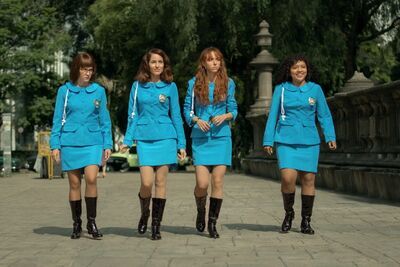

Apple TV’s “Women in Blue” / “Las Azules” is a flawed show. The acting is uneven, with some cast members going full telenovela while others stay in realist drama. Worse, it’s clear that this is a show about women created by men (Fernando Rovzar and Pablo Aramendi, to be precise). All of the episodes are directed by men, and the majority of the scripts are written by men, too.
The beginning is particularly cliché, featuring a bored (and of course beautiful) housewife, who looks for (and finds!) meaning in work after she catches her husband cheating. Even the title sequence reads like a bunch of guys brainstorming markers of femininity – red heels? Check! The woman symbol? Yup! Women getting objectified in swimsuits? Absolutely. And the list goes on.
This surface-level understanding of what it is to be a woman makes some aspects of “Women in Blue” deeply frustrating – including the arc of lead character María (Bárbara Mori), the aforementioned housewife. It also means this 1970s, ostensibly feminist drama fails to have much to say about gender dynamics in the workforce, even as its whole plot centers around the women who sex-integrated Mexico’s police force. “Mad Men” this is not.
Still, it got me. “Women in Blue” has an enticing mix of elements, a certain hodgepodge that shouldn’t work but does. It’s a thriller as our titular “Women in Blue” use their police training to track down a serial killer targeting young women. There’s a “Silence of the Lambs” element when María hits up an infamous, incarcerated serial killer for advice.
Then there’s the historical fiction aspect (“inspired by true events” as they say), complete with go-go boots, macrame beads, and white-roofed Cadillacs. “Women in Blue”’s take on the era’s sexism doesn’t go much deeper than that “it was bad,” but the critique is still there, reminding us that not so long ago (and maybe even today), the idea that women could serve effectively as protectors of the peace was entirely foreign.

Then there’s the commentary on policing itself. “Women in Blue” shines in how it dramatizes detective work, ringing suspense from how Ángeles (Ximena Sariñana) finds and organizes data (in the 1970s we’re talking paper files here). The show also presents various interrogation techniques, ranging from torture to compassion to much effect. Indeed, it’s particularly insightful when Gabina (Amorita Rasgado), the estranged daughter of the police chief, gets an insider’s perspective of what it really means to be a cop. State-side audiences may brush off this learning, believing Mexican police are inherently corrupt but the truth is more complicated, and “Women in Blue” does a good job of exploring that complication.
But this series is best at the blood-pounding thriller of it all. It builds a complex chase with the clues scaffolding nicely upon each other. When we get the killer’s back story, “Women in Blue” mines it for typical ideas of trauma and neglect but also delivers a strong rebuke of the typical violent-past-as-destiny trope.
As the cliffhangers mount, the suspension and stakes go with them. I prefer to watch my TV before bed and this show required an hour to decompress after – such was my state after exiting this intense, plot-driven environment.
Yes, it’s feminism light (perhaps at the lightest: set in the past with no lessons other than things have gotten better). Yes, it’s a show that critiques policing but ultimately makes a hero out of those who don the badge. And yes, the direction and writing are uneven (it’s not until writer Silvia Jiménez’s seventh and eighth episodes that the characters finally start to get some human depth).
But it’s also a thrilling and satisfying ride, combining predictable genre elements with surprising turns. I was jumping in my seat, staying up too late and enjoying “Women in Blue” quite a lot, despite its many imperfections.



